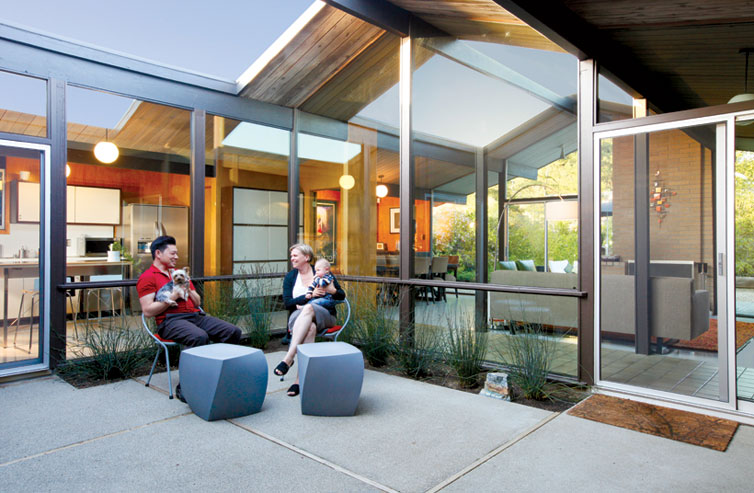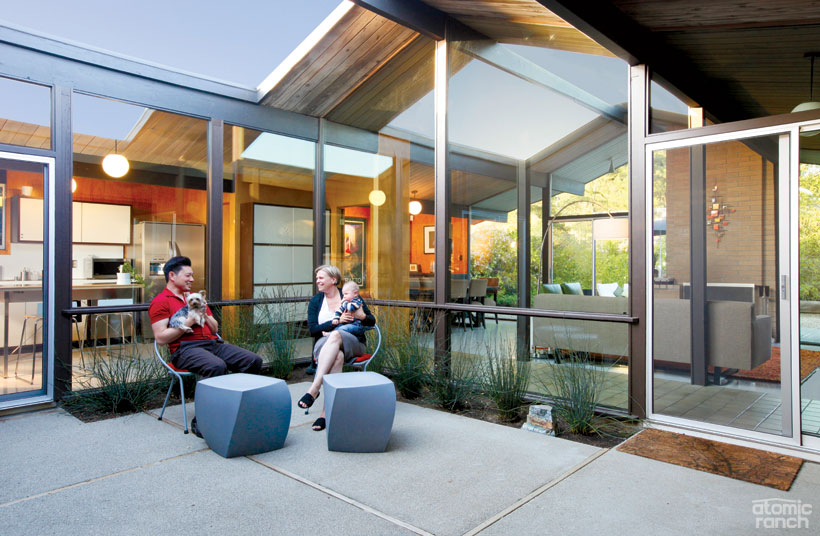
The Ngs are perhaps a typical youngish American couple: Calvin is a graphic designer in the Bay Area, and Kimberly is staying at home with their baby son, Jaden. When they tired of sharing condo walls with neighbors, the pair began the hunt for a house with a) a fireplace and b) a back yard. What sounds like pretty flexible parameters was complicated by two different aesthetics.
“I like a more classic style and Cal is more of a modernist,” says Kimberly, 39, a former human resources manager. “We were trying to find a happy medium for both of us. The outdoors/in and the indoors/out scenes that run through Eichlers is what really got us.”
“Given the fact that we were Eichler virgins, we bought books, joined the Eichler Network and went on any tours we could find,” Calvin, 42, explains. They discovered most homes on the market had been inelegantly updated and, after a year and a half of searching, figured they were facing a major remodel. But then an untouched 1965 house popped up.
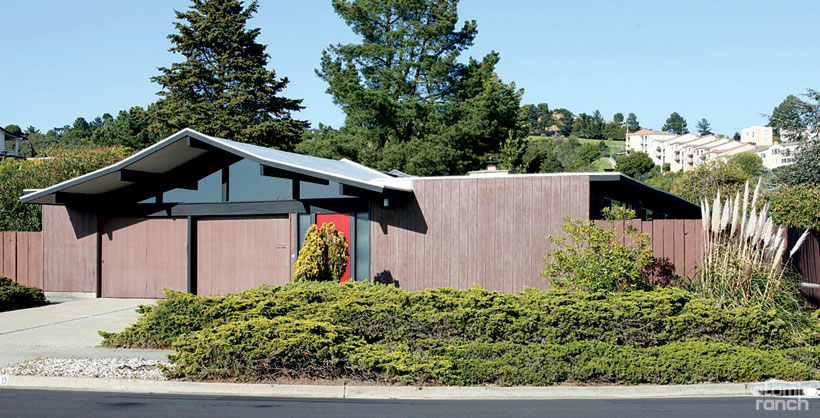
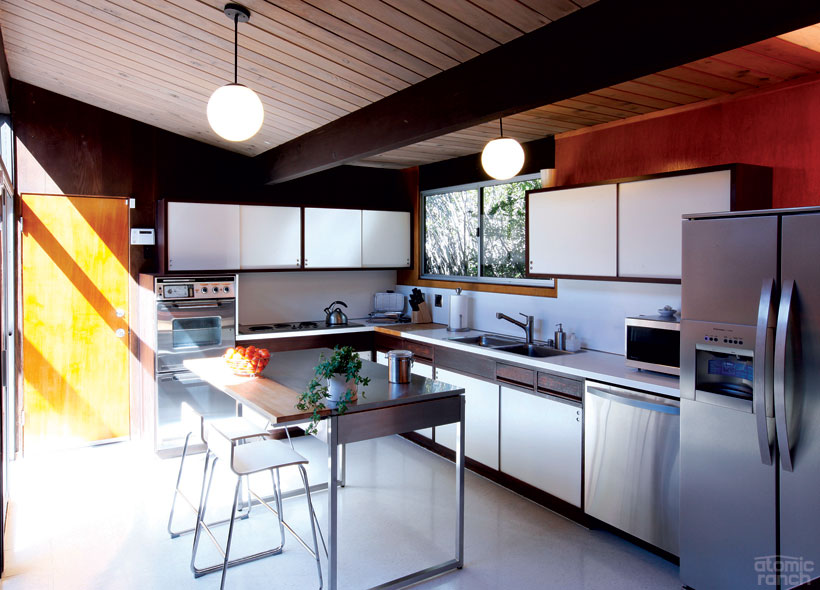
You’re so fine and you’re mine
Located in Sequoyah Hills, a smaller, later development of Joseph Eichler’s in Oakland, the house is one of fewer than 50 designed by Claude Oakland, A. Quincy Jones and Frederick E. Emmons. Styles include double A-frames, flat roofs and the Ngs’ pagoda model. One of their neighbors, an African American original owner, told Calvin she bought because the tract was among the few that didn’t have racially exclusive deed restrictions back then.
“This home was vacant for seven years before the son of the original owner decided to put it on the market. We went to the open house and totally fell in love with it,” he recalls. “It was the most original Eichler we’d seen. The only obvious areas that needed fixing were the old asbestos floor tiles, the front and side doors, and two dryrotted beams in the atrium.”
The list of intact original details was long: kitchen appliances, including a never-used oven, dishwasher and waffle maker; all light fixtures and rocker-style switches; bathroom tile, fixtures and cabinetry; grass cloth–covered closet doors; sliding garage doors; and an untouched fireplace. The 1,655-square-foot home even came with its Eichler manual and brochures, a plan of the development and the original rotary phone.
“When we first got into the house, we were leaning more toward the purist side,” Kimberly says. “But as we’ve lived here, we talk about upgrades or other things that it would be nice to do. If we’d found an Eichler that had been totally messed with, we could go ahead and trick out a kitchen or make a crazy, awesome bath. Our bathrooms are in great shape, but there are times when you wish the vanities were a little higher so you don’t have to bend down two feet to wash your face. But because it’s so original, we just can’t do it—it would ruin the integrity of the home.”
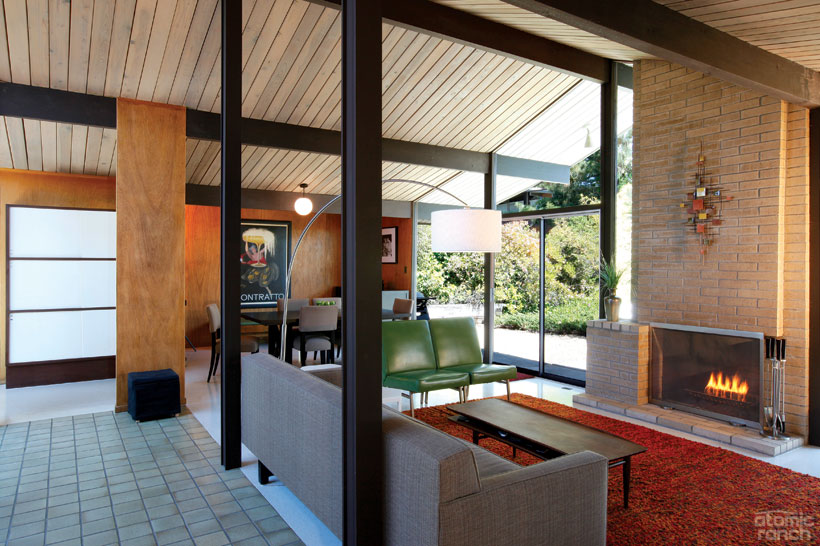
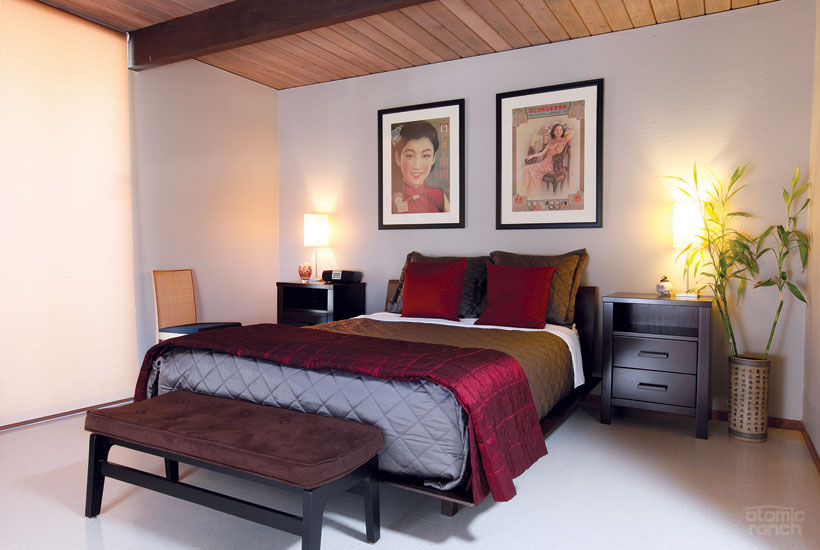
Touched for the very first time
Since the house was 95% original and the Ngs restrained the urge to tear out 45-year-old elements to make the house “theirs,” they focused on thoughtful improvements and furnishings. With heating bills running as high as $450 a month, they decided to replace the windows and sliding glass doors with Blombergs, the closest in style to the original Arcadia units the house was built with. They also installed new water-wise Toto toilets and
faucets in the baths and kitchen.
A contractor was hired for the heavy lifting but the Ngs ran into reliability and follow-through issues. Things got heated enough that they had to switch contractors partway through the renovation. Kimberly, who functioned as project manager, strongly advises others to thoroughly pursue references and set up a timetable for deliverables and expectations. And don’t forget the little things: “I just assumed automatically that contractors would clean up after themselves,” she says, followed by a knowing laugh. “I wish we could have done all of the work ourselves, but we’re not that talented.”
Continuity of materials in their home is all-important: the buckled asbestos floor tiles were replaced with speckled white Armstong vinyl composite tile, a close match to the original flooring and economical, too. The VCT runs from the kitchen into the dining room, through the living room and even into the three bedrooms, making the open floor plan flow. All rooms were painted, and the posts, beams and window frames are the same color inside and out, an important detail in a home with walls of glass.
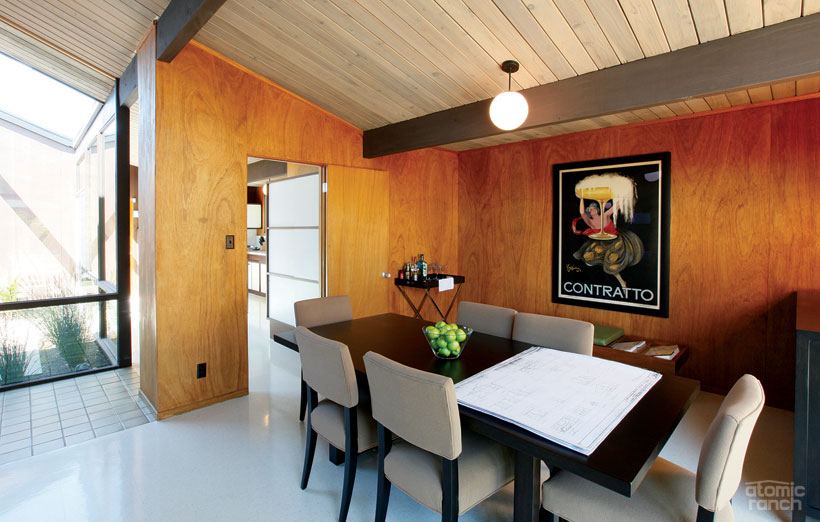
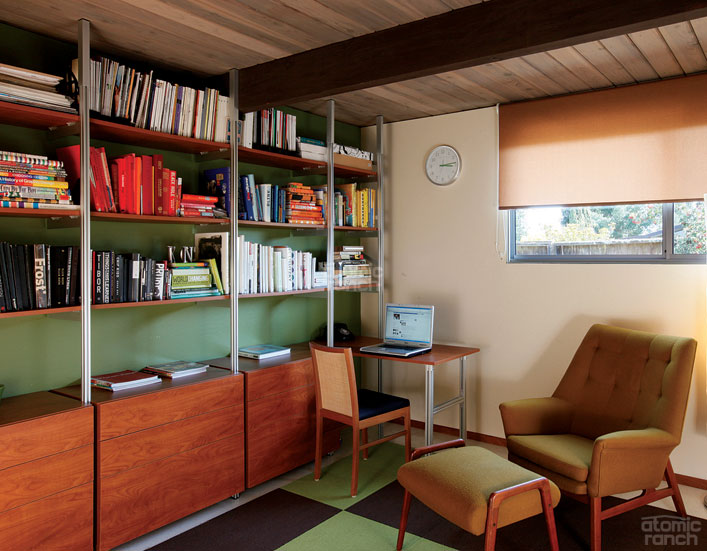
[Still] shiny and new
It’s unlikely that most of us will find a home whose oven had never been used like this one, but there are great lessons in the modest kitchen. Postwar, laminate counters were hugely popular in modernist homes, and it’s still an excellent choice. The material comes in myriad colors and patterns and is extremely affordable; judging from the Ngs’ Eichler, it’s plenty durable, too. Hot pots can be set on the built-in wood cutting board near the cooktop, or on the stainless steel IKEA worktable. Still, Kimberly has those what-if days.
“I’m a classically trained chef, so dealing with a 1965 kitchen is a bit of a challenge,” she laughs. “We would love to have gas, and I’m on the fence because one of the electric burners is out; repair shops don’t want to even come out to try to service it. And the ventilation is not the best, so you can forget about doing anything seared or blackened. There are times when I’m cursing the kitchen.
“We’ve done some research on replacement appliances, and Thermador makes a gas cooktop that’s the same shape and a good aesthetic,” she adds. “But since there are cabinets right above it, we’d have to think about some flashing or ventilation.”
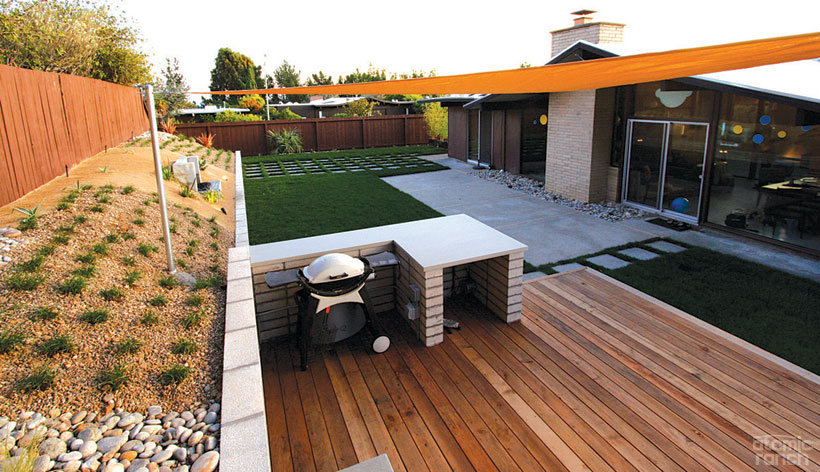
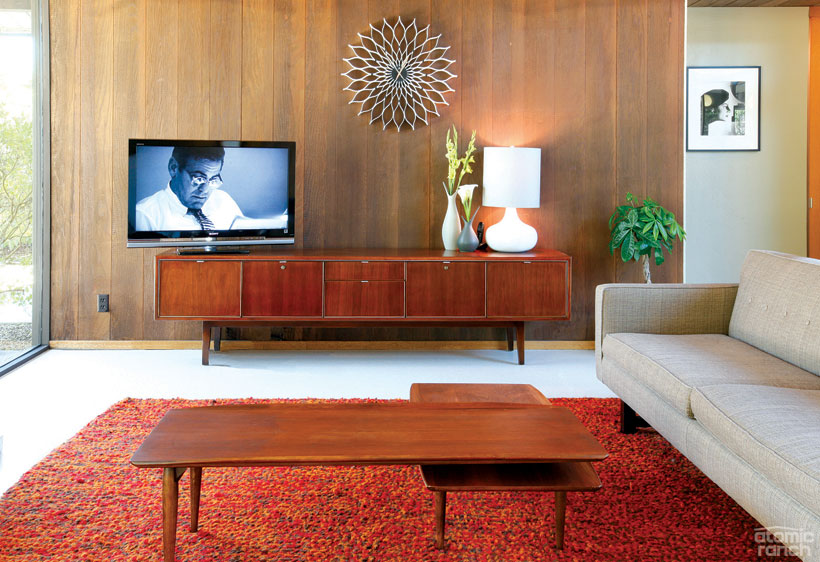
Living in a material world
For his part, it was important to Calvin to replace the big-box front door and lock set with stylistically appropriate ones, along with new midcentury house numbers. “It didn’t look like an Eichler without it,” he says. When it came to the furnishings, that’s when the couple’s differences were most evident.
“My personal style is modern—Frank Gehry, Philippe Starck—but Kimberly has a very different style. When we’re deciding on a piece, we have to both agree. It’s very hard—that’s why it takes us a while,” Calvin comments.
“If it wasn’t this house, I’d say I’m more of a Crate & Barrel, Pottery Barn–type of gal,” Kimberly adds. “I like comfy, big, overstuffed couches but I’m not cluttery; I’m very clean-lined. The house totally dictates what our aesthetics are now. We each have veto power, but you’d think something as simple as a side table would be easy as pie. It’s taken us months and months to find the perfect one—a Noguchi Cyclone table.”
Furnishing an entire house, including a nursery, was a tall order, one they didn’t want to blow. “Midcentury modern furniture is square by nature,” Kimberly says. “Our living room was starting to feel very boxy—we needed something more organic and free-flowing. Val Ibardolasaat Retro@Home came in to give us an interior design layout so the living room and dining room would work together. She had some great ideas on pieces and a suggested furniture floor plan.”
The house has continued to evolve since we photographed it, with the couple adding and moving furniture, and investing in new landscaping front and back. Even though it’s tempting to drool over the killer kitchen or boutique hotel bath in the latest shelter magazine, the Ngs know they found a jewel that many MCM enthusiasts would snap up in a heartbeat.
“On a weekly basis I say how much I love this house,” Kimberly says. “If we were ever to move, it would be into another Eichler.”
As for Calvin, there’s pride in doing right by their home and making a stand for the future. “Eichlers are beginning to be lost pieces of art, and someday may be lost forever if no one preserves these gems.”

